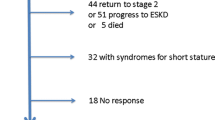Abstract
We examined the growth, development and nutritional status over a period of 10 years of 15 young children (<2 years old) on continuous ambulatory peritoneal dialysis (CAPD). There were 6 males and 9 females with a mean age of 12.5 months, mean weight of 6.3 kg, mean height of 66.2 cm at the start of CAPD and a mean duration of therapy of 2.6 years. Height, weight, head circumference, development quotient (DQ), blood chemistry and dietary intake were assessed over a period of 10 years. The patients' mean height standard deviation score (SDS) did not change significantly (from −2.51 to −2.74) during CAPD therapy. The mean growth velocity index (GVI) during CAPD was 76.5% and correlated positively with energy intake but not with protein intake. The mean DQ was low (67.0%) at the start of CAPD and 69.3% at the end of CAPD. DQ did not correlate with energy intake, GVI, head circumference SDS or with the weight/height ratio; however, 2 patients with low DO (<60%) had a low energy intakes. Although most patients had a low DQ, the IQ at 5–6 years of age was normal in all patients except 1 without cerebral disease. Our study showed minimal growth (ΔSDS) and mental developmental (IQ) delays during CAPD therapy, but an adequate nutritional intake must be assured to obtain the above results.
Similar content being viewed by others
References
Hurley JK (1978) Kidney transplantation in infants (letter). J Pediatr 93: 538
Polinsky MS, Bruce AK, Stover JB, Frankenfield M, Baluarte HJ (1987) Neurologic development of children with severe chronic renal failure from infancy. Pediatr Nephrol 1: 157–165
Rotundo A, Nevins TE, Lipton M, Lockman LA, Mauer SM, Michael AF (1982) Progressive encephalopathy in children with renal insufficiency. Kidney Int 21: 486–491
Betts PR, Magrath G (1974) Growth pattern and dictary intake of children with chronic renal insufficiency. BMJ 27: 189–193
Alexander SR, Arbus GS, Butt KMH, Conley S, Fine RN, Greifer I, Gruskin AB, Harmon WE, Mcenery PT, Nevins T, Mogueira, Salvatierra O Jr, Tejani A (1990) The 1989 report of the North American Pediatric Renal Transplant Cooperative Study. Pediatr Nephrol 4: 542–553
Opelz G (1988) Influence of recipient and donor age in pediatric renal transplantation. European collaborative transplant study. Transplant Int 1: 95–98
Kohaut EC, Whelchel JR, Waldo FB, Diethelm AG (1985) Livingrelated donor renal transplantation in children presenting with endstage renal disease in the first month of life. Transplantation 40: 725–726
Warady BA, Kriley M, Lovell H, Farrell SE, Hellerstein S (1988) Growth and development of infants with end-stage renal disease receiving long-term peritoneal dialysis. J Pediatr 112: 714–719
Kohaut EC, Whelchel JR, Waldo FB, Diethelm AG (1987) Aggressive therapy of infants with renal failure. Pediatr Nephrol 1: 150–153
Rizzoni G, Basso T, Setari M (1984) Growth in children with chronic renal failure on conservative treatment. Kidney Int 26: 52–58
Alexander SR (1984) Treatment of infants with ESRD. In: Fine RN, Gruskin AB (eds) End-stage renal disease in children. Saunders, Philadelphia, pp 17–29
The Japanese Ministry of Welfare (1989) Recommended dietary allowance for Japanese (in Japanese). The Japanese Ministry of Welfare, Tokyo
Enjoji M (1984) Enjoji methods of developmental scale for young children (in Japanese). Keio Tusin, Tokyo
Tanaka Education Institute (1987) Tanaka-Binet intellectual examination (in Japanese). Taken, Tokyo
Mothers' and Children's Health and Welfare Association (1981) The growth data of young children and infants-1980 (in Japanese). Mothers' and Children's Health and Welfare, Tokyo
Qamar IU, Balfe JW (1991) Experience with chronic peritoneal dialysis in infants. Child Nephrol Urol 11: 159–164
Abitobol CL, Zilleruelo G, Montani B, Strauss J (1993) Growth of uremic infants on forced feeding regiments. Pediatr Nephrol 7: 173–177
Masuda H, Kamiyama Y, Honda M, Hasegawa O, Ito H (1990) Calcium metabolism in children with chronic renal failure: the effective dose of 1 α(OH)D for control of renal osteodystrophy in children on CAPD. Abstracts of the Eleventh Congress of Nephrology, Tokyo. International Society of Nephrology, Tokyo, pp 22A
Polinsky MS, Kaiser BA, Stover JB, Frankenfield M, Baluarte J (1987) Neurologic development of children with severe chronic renal failure from infancy. Pediatr Nephrol 1: 157–165
Geary DF, Haka-Ikse K (1989) Neurodevelopmental progress of young children with chronic renal disease. Pediatrics 84: 68–72
Broyer M, Niaudet P, Champion G, Jean G, Chopin N, Czernichow P (1983) Nutritional and metabolic studies in children on continuous ambulatory peritoneal dialysis. Kidney Int 24 [Suppl]: S106-S110
Salusky IB, Fine RN, Nelson P, Blumenkrantz MJ, Kopple JD (1983) Nutritional status of children undergoing continuous ambulatory peritoneal dialysis. Am J Clin Nutr 38: 599–610
Kopple JD (1978) Abnormal amino acid and protein metabolism in uremia. Kidney Int 14: 340–348
Honda M, Hasegawa O, Kawamura T, Ito H (1987) Serum amino acid pattern in children with end-stage renal disease (in Japanese). Jpn J clin Dial 3: 251–257
Bricoe DM, Kim MS, Lillehei C, Erakis AJ, Levey RH, Harmon WE (1992) Outcome of renal transplantation in children less than two years of age. Kidney Int 42: 657–662
Najarian JS, Frey DJ, Matas AJ, Gillingham KJ, So SKS, Cook M, Chavers B, Mauer SM, Nevins T (1990) Renal transplantation in infants. Ann Surg 212: 353–367
Author information
Authors and Affiliations
Rights and permissions
About this article
Cite this article
Honda, M., Kamiyama, Y., Kawamura, K. et al. Growth, development and nutritional status in Japanese children under 2 years on continuous ambulatory peritoneal dialysis. Pediatr Nephrol 9, 543–548 (1995). https://doi.org/10.1007/BF00860924
Received:
Revised:
Accepted:
Issue Date:
DOI: https://doi.org/10.1007/BF00860924




